Going wild with the Mustangs, old and new
Ford’s pony car, the Mustang is finally here. Shapur Kotwal takes the new one and the first Mustang ever to meet some real wild horses.
Published On Oct 29, 2016 08:00:00 AM
23,500 Views
Follow us on
Chiseled, hard edged and menacing; both Mustangs are stunners.


Owner SB Jatti loves to go on long drives.

It’s a bit too red, but eventually everyone says they like it.
At first, man had almost no speed. We could jog and we could manage short sprints. But speed, compared to the rest of the animal kingdom? It really wasn’t our thing. To compensate, we learnt to use our head. This initially led to better stuff like weapons, fire, flint and tinder (no, not the app), which helped make us more effective hunters.
But then, man transcended his natural limits by leaping on the back of a horse. The increase in speed was massive – while we can run at an average of 20kph (unless you’re a certain Mr Bolt who hit an incredible 44.64kph in 2009), a good horse can manage 55. This, depending on whom you ask, happened somewhere around 3500BC, in what is now modern-day Kazakhstan. And the horse continued to be our fastest mode of transport until it was fully replaced by the car somewhere in the early 1920s – roughly 5,000 years later!
So, is it any wonder then that the horse and speed are inexorably linked? Sure, the real iron horse is a motorcycle and the car is actually a horseless carriage. But think of it in a broader sense and it’s the car that replaced the horse. Speed, power and performance are also what you represent when you use a horse as a totem. And a powerful totem it is – just look at the aura of success the horse has conferred upon sportscar makers, all of them super successful. There’s Ferrari, of course, and Porsche (there’s a horse in the shield of Stuttgart), and then there’s the latest entrant into India, Ford’s Mustang, a car that’s literally “democratised” horsepower.
So what better way to welcome it into the largest democracy in the world then, than to take the first Mustang to hit our streets and the first Mustang ever and drive them to a place full of, well, some wild horses?
In The Flesh
One Mustang is good enough to stop traffic. Two, both in red, standing next to each other, can spark a riot. And they did, just like that: people were fighting to take selfies against the duo. So we decided to move a couple of kilometres up the road. But the cars drew a crowd again, and people just stared and stared.
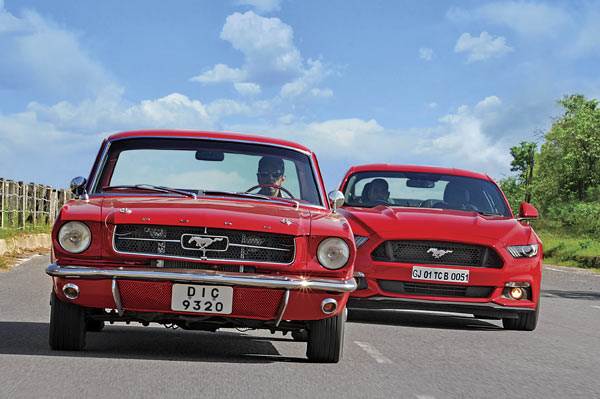
I sort of understand that; I stared and stared too. The proportions on both the Mustangs are clearly right. The basic ‘long in hood and short in deck’ (long bonnet, short boot) silhouette works a treat. And I simply love the detailing.
What a sensation SB Jatti’s 64-1/2 Mustang must have caused when it first hit Ford showrooms in the US! The car looks sort of contemporary even today. Have you seen what other American cars looked like in the ’60s? I just love those sunken headlights, I love that the nose has a bit of an ‘underbite’ and that kink in the shoulderline also lends just the right amount of dynamism. And don’t those white walls simply rock? I don’t like the faux vents near the rear wheel arches though – they look a bit out of place.
The new car, the first one let out by Ford on our roads, clearly looks more menacing. The wide ‘hood’ and open mouth give it the look of an angry cobra, and the low roof lends it a sportier stance than the ’64. But the basic look and feel of the car are still there; even half a century on, you can easily tell that this is a Mustang. Can’t mess too much with these icons, can you? I think Ford has done a stellar job. The letters F-O-R-D, however, no longer adorn the bonnet – guess every hick in Louisiana knows who makes the Mustang. The chin of the new car is a bit cluttered and there’s a bit of flab around the body, but apart from that, I think the car’s the bee’s knees. I even like the ‘fastback’ (American slang for a raked hatchback) styling more than the conventional boot of the original – a trend that began back in August ’65.
Iconic For A Reason
Of the two, the old 64-1/2 clearly has the more attractive interior. It’s red, for crying out loud, is full of vinyl, leather and chrome, and makes me feel like I’m sitting in an American diner. The first minute is lost in looking around in wonder, mouth open. I’m not sure... but I think I like it. Even the steering wheel is red! The driving position is armchair-comfortable and though the big steering wheel means you need to slide your thigh under, getting in and out of the car is also a breeze. The Mustang, remember, was billed as a more fun replacement to a family car.
It also wasn’t cool to have a round speedometer in the sixties, so like many Fiats of the era sold in India, the original Mustang got a horizontal bar instead of a speedo. The gramophone look is completed by two dials at either end that look like speakers, and I love the hooded binnacles – there’s one for the passenger as well.
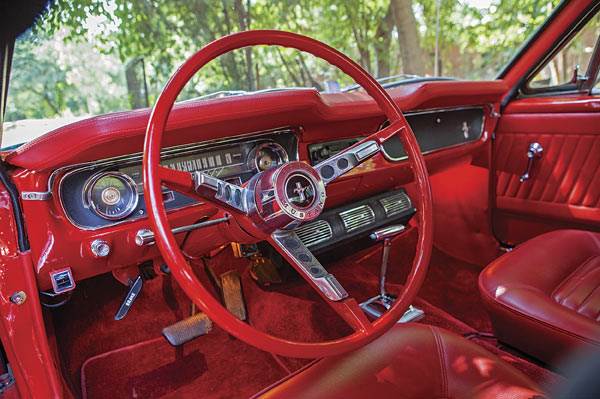
The original Mustang was also a car that allowed the customer to choose whatever they wanted on it. Check out the eye-popping list of ‘accessories’. There was a choice of four engines, three clutches, seven transmissions, two drive shafts and four brake systems! Even disc brakes were optional, according to Ford’s official communication of the time, and this car has them.
Setting off in the 64-1/2 is easier than I imagine; it does have a V8 and an automatic, and though the 289 CID engine doesn’t have a massive amount of power, there’s still loads and loads of torque – 407Nm at 2,800rpm. The engine is also smooth, pulls without hesitation from low speeds and though the typical V8 burble and the big lusty Yank iron-block pull are missing, the Mustang gathers speed in an impressive manner. Do remember, this car is more than half a century old, and though the engine displaces 4,727cc, max power is only 213hp.
While this is not what I’d expected initially, the engine keeps pulling harder and harder the more I rev it. And the increase in pace is nice and linear, so it feels more sportscar than pure muscle car. The last 2,000rpm of the rev band is particularly nice, as the car pulls hard and clean until the next gear is selected. It feels like it will do 100 in around 11 or 12 seconds – quite amazing, all things considered. And this is with a power-sapping automatic. With a manual, I’m sure you’d be able to knock two or three seconds off, easy.
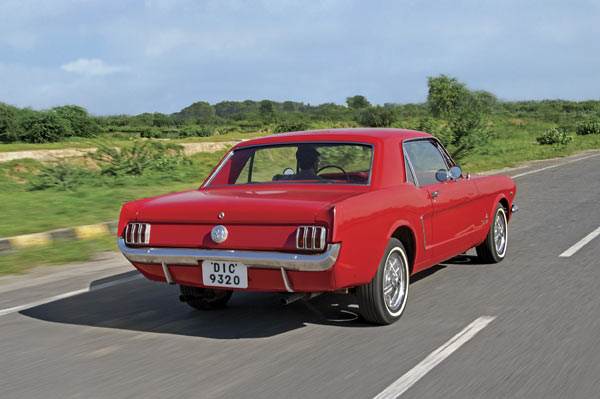
I’m even impressed with how it drives. The ’64 is less susceptible to pitch and float than any American car of its age. The ride is quite absorbent, even over bad patches, and the suspension works silently. It isn’t a sporty drive, however. Yes, compared to American cars of its age, again, it has more grip and less pitch and roll, but on this standard suspension, the Mustang is more a neat and tidy sedan than proper Grand Tourer. Yes, you can turn the car into corners smartly and you can accelerate out of corners as well, but you have to be patient, measured and precise. That said, I’m sure it will work a treat on flowing country roads, with its pencil-light steering wheel, ample power and decent grip.
Modern Times
Question is, is the modern Mustang similar? I expect the 410hp 5.0-litre V8 will dominate proceedings, so my first instinct is to pay homage to the engine. The bonnet is heavy, it needs something of a clean and jerk, and it’s long and wide too; but boy oh boy, do I like what I see! The V8 engine is simply massive, and though there are plenty of plastic bits around, the Ford engineers have allowed plenty of slab-like bare metal to poke through as well. I’m blown away – I’d forgotten how attractive a well-dressed engine can look. And doesn’t it have it all – purpose, intent, potential, the lot!
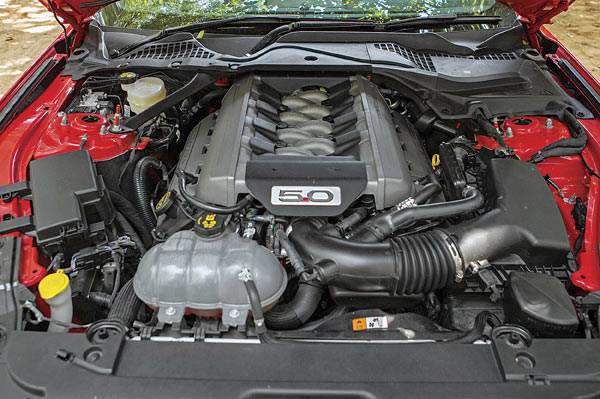
This sense of occasion carries on the inside as well. The design isn’t exactly as retro as something like a Mini, but the Mustang blends modern and pony-car tradition pretty well. I like the fact that the hooded binnacles have been carried over, I like the design of the centre console with the band of brushed aluminium running across it, and though the build isn’t great, I just love the chromed-over toggle switches. And what does the speedometer say? Ground speed, ha ha! Sure, the plastic quality in many places isn’t on par with cars it wants to compete with, and the leather seats aren’t of the same quality either, but the cabin is huge, the seats are comfortable and there’s loads and loads of space. Even the rear seats are pretty useable.
But the Mustang isn’t about all that. It’s about that big 5.0-litre V8. And man, does this motor deliver. First impressions, however, are a bit surprising. Just like the 64-1/2, this V8 doesn’t do all its best work by 3,500rpm. There isn’t a massive explosion of power and torque when you whack the throttle open, and unlike something like the 6.4 Hemi under the bonnet of the Jeep Grand Cherokee SRT, it doesn’t kick like a mule either. What you get instead is so perfectly tailored to the car, I’m soon grinning like Mickey Mouse.
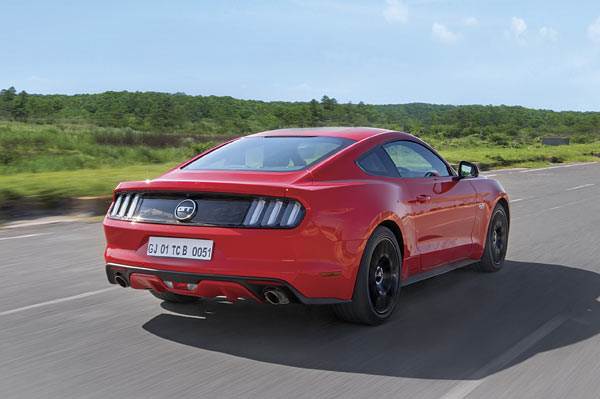
Yes, the engine note should have been more ‘in your face’, bigger and brassier, and that steam catapult take-off is missing, but the manner in which this motor gets stronger and stronger as you go further up the rev band, for me, is infinitely more thrilling. More American racing car V8 than big truck motor, the Mustang’s engine pulls hard all the way to 6,500rpm, extremely high for a big Yankee lump like this one. And the super thing is that it pulls harder and stronger the more you wind it, which feels just brilliant. The performance towards the top end is truly searing and easily as good as cars that are nearly twice its price. The six-speed automatic gearbox, however, feels so slow, it seems like it has been lifted from an MPV – there’s nothing remotely sporty about it. Oh, what I’d do for a manual instead!
What makes me want to cross continents in this car is the rock-solid straight-line stability and the fantastic steering. There are three modes for the latter and they each alter the weight considerably, but the middle setting is clearly the best. And though the massive Mustang really does feel like a battleship from behind the wheel – long bonnet and wide haunches and all – it feels surprisingly agile too. No, don’t get me wrong, I’m not saying it will dart into corners like a Porsche Boxster or howl around corners like a BMW M3. But it doesn’t have that American marshmallow-like suspension either. It turns into corners with a surprising amount of enthusiasm, it settles on its springs pretty quickly, and you can then use that fantastic V8 to reel yourself out of the corner. Yes, if you try and hustle it through a set of switchbacks, it will get sloppy and scary. But point it into a corner, be patient and then add power smoothly, and the Mustang feels pretty special to drive. And it even rides well, soaking up most of our potholes and broken patches with a nonchalance that’s truly commendable. There is a bit of firmness too, but then, it has to be there, doesn’t it? How else can you put down 401hp?
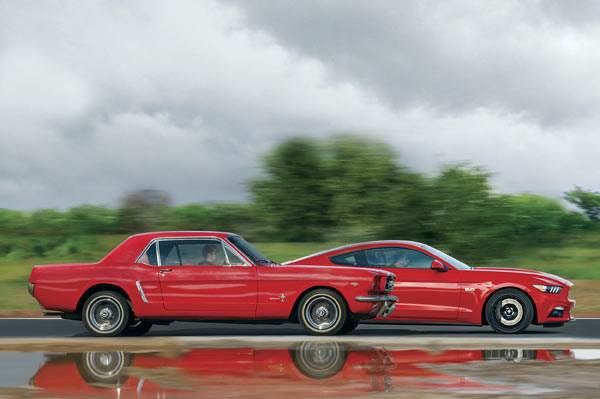
Our photo shoot ends at the stud farm, where we are treated to the incredible sights and sounds of thoroughbreds thundering past the cars, their massive muscles flexing, their manes flying in the dust. What a display of power, performance and muscle! And what an icon the Mustang is. It does have its shortcomings – more than a few, actually – and a manual gearbox is much needed, but the fact that it delivers so much car for comparatively so little money simply makes it one of the best performance cars on sale today. What’s also clear is that the spirit of the wild horse continues to live on in those who choose to honour it: Ferrari, Porsche and Ford’s Mustang, they have the right stuff. As the 61st Cavalry’s motto states ‘Ashwa Shakti Yashobal’, horse power is forever supreme.
Location courtesy: Divyug Stud Farm, Gurgaon.
Copyright (c) Autocar India. All rights reserved.



Comments
Member Login
Personal Details
No comments yet. Be the first to comment.